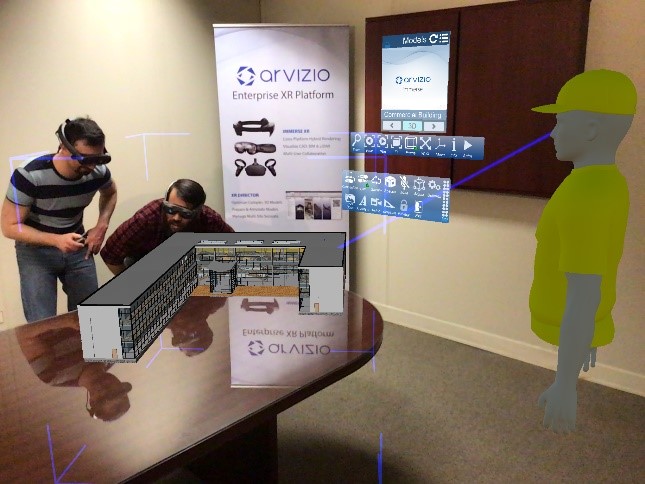
In Augmented Reality and Mixed Reality News
April 6, 2020 – Arvizio has today announced the enhancement of its XR Platform with an expanded feature set and an increase in supported spatial data formats. The company’s XR Platform is designed to offer enterprises a complete solution for optimization, visualization and collaboration using 3D CAD, BIM, LiDAR, 3D scans and photogrammetry models, with the company focusing particularly on AEC, energy, mining, engineering and advanced manufacturing applications.
In the new release, Arvizio has introduced its XR Connect sharing services, which provide a fully synchronized sharing session in cross platform, multi-location design reviews, including audio bridging so that participants can communicate in real time. In addition, the annotation feature allows model mark-ups to be shared among users.
Arvizio has further expanded spatial data format capabilities by introducing:
- Autodesk Navisworks plugin which allows the import of 3D model geometry and metadata;
- Support for the import of the Bentley Systems MicroStation DGN data format;
- Ability to import E57 LiDAR point cloud data;
- Enhanced support for Autodesk DWG data format.
Highly complex models, such as those created with Navisworks, consist of multiple layers such as structural layers, plumbing, piping and valves, electrical, etc. Once imported into XR Director, the layer structure of the model is preserved, allowing specific layers to be selected and viewed on demand. Arvizio has incorporated additional formats and integrations into its XR Platform, including BIM 360 and Fusion 360 cloud solutions, Revit, Faro and Leica LiDAR formats as well as many common formats such as OBJ, FBX and glTF.
Arvizio’s advanced 3D mesh optimization algorithms allow complex models with many objects (1 million plus) including large buildings, oil refineries and platforms, industrial plants and complex machines to be optimized with per object granularity, according to the company.
Industrial models may be 100M+ polygons and LiDAR scans or Photogrammetry models may be several billion points, well beyond the rendering capabilities of even today’s most advanced AR headsets and mobile devices. To solve this challenge, Arvizio employs hybrid rendering, which allows models to be optimized and then visualized on standalone headsets (such as the Magic Leap One and Microsoft HoloLens 2) and mobile devices by leveraging the GPU horsepower of the XR Director PC or server to perform remote rendering. The hybrid rendering is integrated into the visualization experience.
“Mixed and augmented reality are transforming the design, manufacturing and construction landscape. As leaders in collaborative XR, Arvizio wants to ensure that our customers are provided with the technology to meet their expectations,” said Jonathan Reeves, CEO of Arvizio. “With Arvizio’s innovative XR Platform, organizations can now create seamless collaborative 3D experiences across locations and devices. We’re proud to announce that our latest enhancements to the platform allow for a much more powerful experience.”
Arvizio, along with Magic Leap and Golder, is hosting a free webinar: ‘Transforming the Industrial Enterprise Sector with Spatial Computing’, which is being held on Wednesday, April 8 at 9 AM PDT / 12 PM EDT.
Image credit: Arvizio
About the author
Sam is the Founder and Managing Editor of Auganix. With a background in research and report writing, he has been covering XR industry news for the past seven years.
